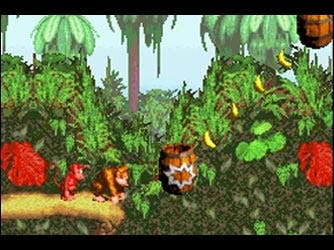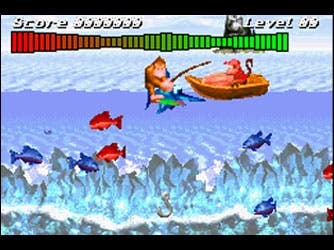Donkey Kong Country
Tom engages in a bit of gorilla warfare.
When Donkey Kong Country arrived oh so very long ago, its "ACM" visuals made the SNES look sexy in ways the Super FX chip and years of development had previously failed to do. But it was the entertaining platform game underneath the pretty packaging that kept the game's core fanbase and propelled the inevitable sequel through the sales stratosphere.
Of course it became fashionable to have "never liked" DKC in the first place, to draw undue attention to its medieval lifespan and even to slag it off for the way it looked, but anybody with a love of 2D platform games couldn't fail to be intoxicated by its mixture of good graphics, varied level design, numerous collectibles and old school characters. Such was the furore surrounding the game, one magazine found itself worried by the sight of an even better game shaping up in the sequel, remarking that "we gave the first one 100 per cent, and this looks even better!"
I see no donkey...

However these days the playing field is well and truly levelled. "ACM" means nothing to most people, and DKC's digitised rendering techniques and fairly intricate visuals can hardly compare with modern standards - and only stack up fairly well on the humble GBA. Good though it does look (certainly nicer than the GBC version of the same game, which differed mostly in terms of minigames and visuals, if that matters to you), if it wants to make its mark on the system then it's going to need to do it on the issue of gameplay. Its once-charming good looks hold little currency here.
The idea is to retrieve Donkey Kong's banana hoard from the thieving Kremlings, by teaming up with budding wannabe hero Diddy Kong. The two traverse many levels in five separate areas collecting items and seeing off a selection of bosses, before taking on the evil mastermind behind it all in a final showdown. Abilities wise, both can run, jump, and perform a barrel roll style attack (which, when followed by a jump, can be used to leap seemingly impossible distances and nab sunken items), and whilst Donkey is heavier (handling a bit like a Yoshi-mounted Mario) and can pound the ground for treats and kill virtually every enemy with a straight bop on the head, Diddy is more agile and probably the character of choice for general use. It was a good balance back in the day.
Fortunately, it doesn't look as though the game's many levels have actually been updated more than a trifle, so nothing's been upset in the gameplay department. From Donkey and Diddy Kong's Kongo Jungle home, where the great banana theft that drives the "story" takes place, through Monkey Mines, Vine Valley, Gorilla Glacier and so on, the familiar shape of each level unravels before you like a well-trodden path, with all the old barrels and enemies in the right places, as well as all of the game's Yoshi-style animal helpers (frog, ostrich, swordfish or rhino) intact. The only real change is the splitting of the map screen into more sections - the old SNES one had every level in any given area on-screen together.
Bonus!

In keeping with the original, there are also a certain number of bonus rooms hidden within each level, unlocked by finding hidden bonus barrel cannons and breaking down walls by lobbing barrels; and other bonuses like extra lives, earned by spelling the word "Kong" from hidden K, O, N and G letters. And that's not all. Levels and bonus rooms often throw up golden animal helper charms - collect three of each and you unlock the platform equivalent of Supermarket Sweep, taking that particular animal against the clock through a level packed to the very rafters with little animal icons, totting up an extra life for every 100 icons you have when the timer hits zero.
It sounds like a lot of things to get your head around - in addition, by the way, to the bananas that you collect like Sonic's rings or Mario's coins - but it's surprisingly easy to keep track of everything, and the game readily allows you to pour over previously completed levels hunting for those elusive secret rooms and additional extras - until the level name gains an exclamation mark on the map screen, indicating that all the secrets have been unlocked. Oh, and in bringing the game to GBA, Rare (sniff) has even thrown in more than 50 camera icons to collect.
In fact, the sheer number of different threads to keep open in your head - KONG letters, secret rooms, camera icons, animal icons, etc - means that you'll often play each level plenty of times, and there's something about their design that makes even the ones that seem infuriatingly tricky the first time through comfortable and easy to explore under the more relaxed conditions of a treasure hunt.
Barrel of [not a chance -Ed]

The levels certainly are well designed. Although some of them have a tendency to throw in too many "think fast!" type scenarios, with enemies zooming at you out of nowhere, and narrow platforms over bottomless pits of frustrating death, the game generally diversifies well, with some out-and-out platform levels, some more focused on using bouncy tires, some on avoiding traditionally unkillable enemies (like bees and totally indestructible, fast-moving stop-and-go rock monsters), some with rope swinging, some with icy ropes, some underwater ones, some darkened ones where a flashlight-holding birdy hovers above, helpfully (or not) illuminating the area in the direction you're facing, and even the odd mine cart level (and surprisingly good ones at that).
The one thing that binds almost all of them though is the one or two strikes system of buddying, with players switching character with the select button. In practice, this means that you have to be very careful and that you'll regularly be looking around for a "DK" emblazoned barrel to once again unleash your simian sibling. After a while though you expect every level to take multiple goes, and you treat progress with both characters as a given, and any made with just the one is pretty much just exploration - because you'll try and get there with buddy in tow next time around. Finish a level with just the one character and it'll be a nervous but exciting experience as you stumble through the exit - and you'll be waving your arms and cheering just as the Kongs then do on the map screen, before the three of you collect yourselves and move onto the next challenge. Or four, we suppose, because the SNES version's excellent link-up mode survives here (albeit without a link cable - the game pauses for you to hand the GBA over), allowing you to control one fellow each like a tag team.
Is it a bird? Is it a donkey?

And so we come, in a roundabout way, to the only aspects of the game that are really left to judge: those once-astounding visuals and the game's haunting soundtrack. Although the graphics look slightly muddier on the GBA screen, they do look ostensibly the same, and that's a good thing, with plenty of detail in the static backgrounds and level furniture. Each environment is still really lovely to look at, putting a lot of other GBA titles to shame with good definition and little details like hanging latterns, discarded wood and piles of coal in the minecart sections and even trashed consoles and fallen Nintendo signs in Cranky's cabin. And although the characters aren't as well animated as we remember, they too retain all the frames needed to give the gameplay the same feel, and even pause to scratch themselves, pound the floor impatiently and stomp around unhappily when they screw up a "guess the barrel" bonus game.
As for the soundtrack and sound effects - whilst we wish they were coming out of headphones and not the SP's tinny speaker, from the frantic "hoo-hoo-ha-ha-ha!" noise of Diddy banging on the inside of his barrel prison before Donkey smashes it open to the fluttering of the ostrich's feathers as it hovers towards a secret platform, there isn't much to fault.
Then again, when it comes to the game as a whole, it's not all good. Fun though DKC is, it is - as many have said in the past - rather on the short side. Stumbling through the game with a fairly good idea of where everything was, it took us about four hours to get to the final boss and dispatch him, picking up some 70 per cent of the game's secrets along the way. Then again, when we were (much) younger it took us 10 hours to get everything out of the SNES version. So in a sense it depends on your platform skills, and Rare hasn't skimped on bonus content, even if the original levels wisely remain intact. With a new "save anywhere on the map screen" feature thrown in to fit the portable premise (which makes things a little easier), erstwhile save queen Candy Kong's regular boutique stops now offer an increasingly difficult rhythm-action minigame, and plane-owning Funky Kong has bolstered his business with an additional fishing minigame, which sees players zipping around trying to hook various sea-dwelling nasties in increasing quantities and toss them into a neighbouring boat. Oh, and there's a new DK Attack mode, which lets you speed-run the levels trying to set high scores and so on.
Donkey Con?
But, as we said, it's not all good. Some people (particularly old hands) will zip through this in no time at all, and fun though it might be for a little while, it really won't be worth £30 to them. Heck, we'd struggle to justify £30 for most GBA games, but like the Super Mario Advance series, this one really is only worth it if you've never played the game. Heck, if you shop around for the excellent GBC port of the very same game - which works on the same console - then you've pretty much beaten the system anyway. What we really need at the moment is less of these cynical SNES ports, or at least a change in pricing, because once again we're sitting here having enjoyed a fantastic few hours of portable gaming that we could kiss Nintendo for publishing, and being forced to warn most of you off buying it. Dang.

